Photo Essay: Greater and Lesser Scaup
The ever-popular bluebill
The ever-popular bluebill
Greater and lesser scaup share a number of traits, not the least of which is a distinctive blue bill, from which they derive their popular nickname "bluebills." The origin of the term scaup, however, is less clear. Early naturalists claimed that the name stemmed from the birds' habit of feeding on scalp-the Scottish word for clams, oysters, and mussels. But other scholars credit the drake's discordant scaup, scaup call as the name's source.
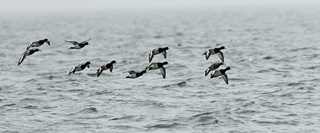
Photo © Michael Furtman
Lesser and greater scaup are counted together in annual aerial surveys because the two species are hard to distinguish at a distance. There are, however, a number of differences. Size is one, as lesser scaup are about 20 percent smaller than greater scaup. Drakes of both species appear similar from afar, with dark heads, white flanks, and gray backs. But greater scaup have white on their primary and secondary feathers extending nearly to the tip of the wing, while lesser scaup only have white on their secondaries. Up close, the drake lesser scaup's head has a purplish iridescence, while the sheen on the greater scaup's head is green. The greater scaup also has a rounder head, wider bill, and larger black nail at the tip of the bill. Both hens are brown with a white crescent patch at the base of their bill.
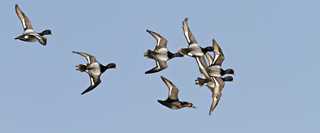
Photo © Michael Furtman
Together, lesser and greater scaup rank third in average duck population estimates in recent years, behind only mallards and blue-winged teal. Lesser scaup alone are the most numerous of all North American diving ducks, accounting for almost 90 percent of the combined scaup population, making them "less" than their cousins in size only.
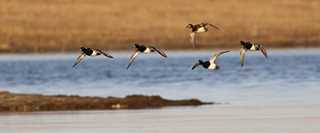
Photo © Michael Furtman
The breeding range of scaup is extensive, reaching from the northern United States through the Prairie Pothole Region northwest to the Bering Sea. The largest breeding population occurs in Canada's western boreal forest. Scaup begin nesting relatively late, usually from late May to mid-June. They prefer territories near deeper, more permanent wetlands with emergent vegetation such as bulrushes, which often hold abundant populations of aquatic insect larvae.
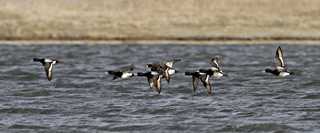
Photo © Michael Furtman
Greater scaup are primarily tundra breeders and winter in coastal areas. The majority of the birds follow the Atlantic and Pacific flyways during fall migration. Lesser scaup can be found in a wider range of habitats, including smaller lakes, and the majority of these birds winter in the Mississippi Flyway, with 30 percent passing farther east across the Great Lakes into the Atlantic Flyway.
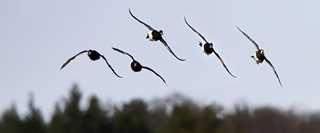
Photo © Michael Furtman
Despite their relative abundance, scaup populations have declined over the past 30 years from about 6.3 million birds in the 1970s to 4.2 million in last year's survey. Ducks Unlimited has supported a variety research to determine the reasons for this downward trend in scaup numbers. While no single cause for this decline has been found, DU is working to protect and restore habitats that are important throughout the scaup's annual cycle, including key breeding areas such as the western boreal forest, important migration areas like the Great Lakes, and southern wintering areas such as the Gulf Coast.

Photo © Michael Furtman
Visit DU's Waterfowl ID resource to get more information and images regarding bluebills.
Ducks Unlimited uses cookies to enhance your browsing experience, optimize site functionality, analyze traffic, and deliver personalized advertising through third parties. By continuing to use this site, you agree to our use of cookies. View Privacy Policy